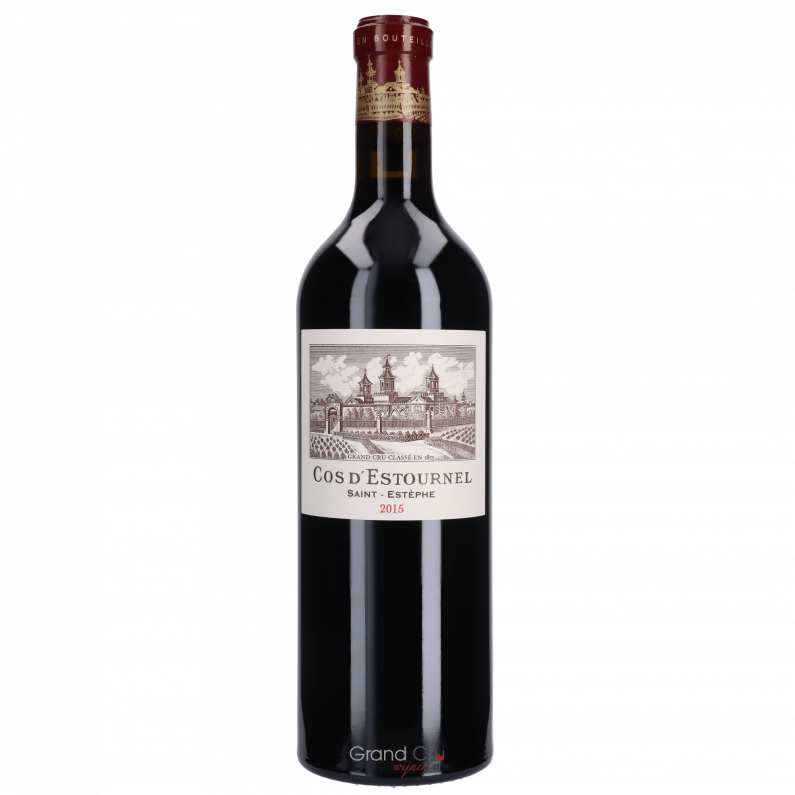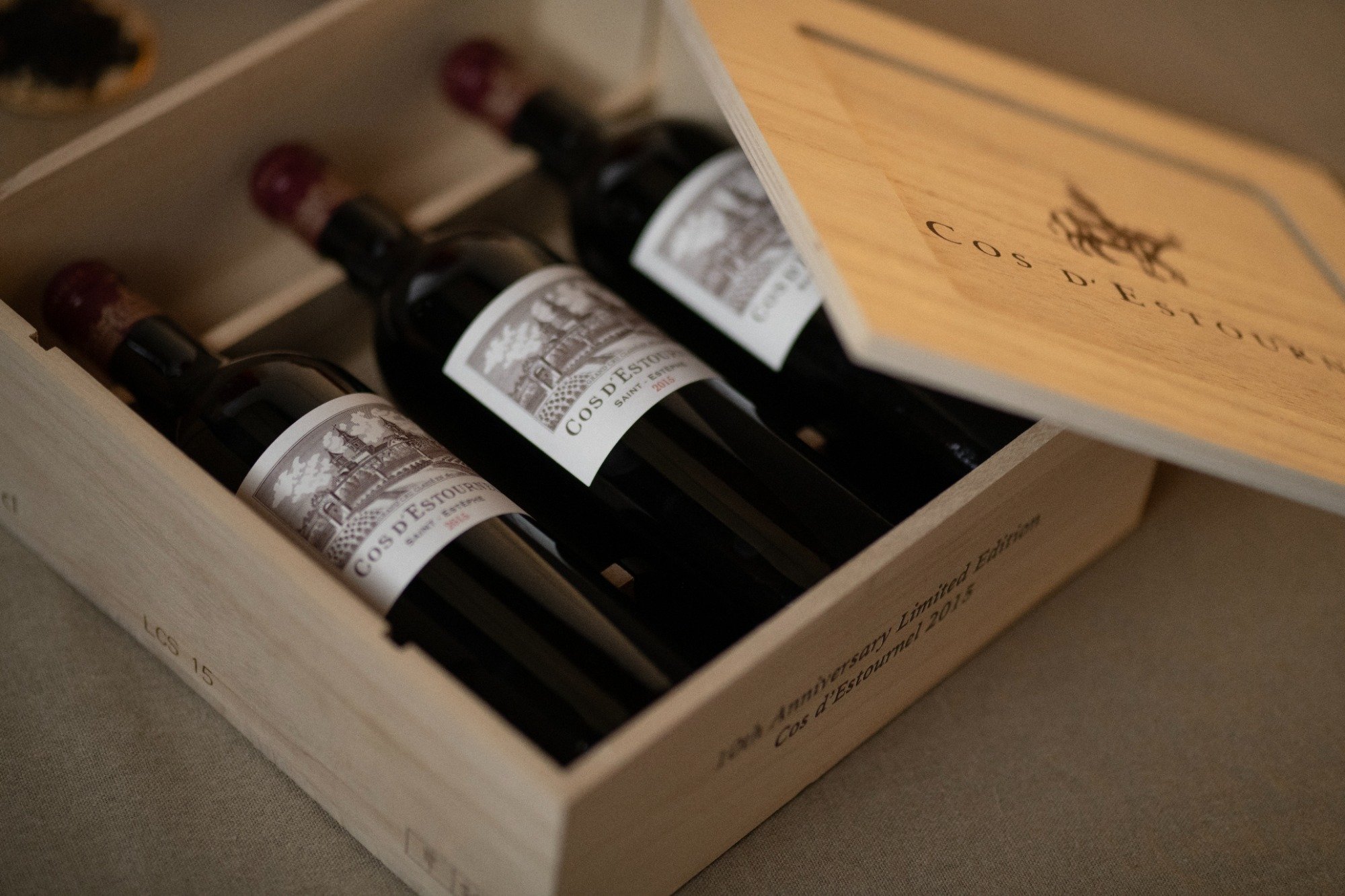2015 Château Cos d'Estournel 10th Anniversary Limited Edition OWC/3

De specificaties zoals vermeld bij de wijn (o.a. wijnjaar) en in de titel zijn leidend en er kunnen geen rechten worden ontleend aan de afbeelding die wordt getoond. Lees meer in onze Frequenty asked questions
| Type of Wine | |
|---|---|
| Country | France |
| Region | |
| Appellation | Saint-Estèphe |
| Winery | |
| Vintage | 2015 |
| Grape | , , , |
| Content (Alc) | 0.75 ltr (13%) |
| Drink window | 2022 - 2050 |
| Available as of | Dec 10, 2025 |
Out of Stock
Currently unavailable
Notify me when this product is back in stock
Description
The former owner and namesake, Louis Gaspard d'Estournel, was known as the Maharaja of Saint-Estèphe. He decorated the château in Indian style, threw lavish parties, and lived beyond his means. In 1852, he was completely destitute and had to sell his estate. He died a year later. Cos d'Estournel is perhaps the château with the most modern and advanced winemaking technology. From harvest to aging in the bottles, everything is meticulously monitored and carried out with the utmost care. For example, they managed to create a vinification process in which the wine is transported without pumps. All operations are carried out by gravity. In 1855, the château was awarded 2nd Grand Cru Classé status.
The 2015 Cos d'Estournel is blended from 75% Cabernet Sauvignon, 23.5% Merlot, and 1.5% Cabernet Franc. The opaque purple-colored Cos d'Estournel offers a beautifully sweet nose of ripe blackberries, Provençal olives, smoked herbs, toasted bread, and licorice. Rich and powerful, yet elegant and stylish. One of the finest vintages, it earned a 95/100 Parker rating.
In the attachment you will find photos and the fact sheet of this beautiful wine

Specifications
| Available as of | Dec 10, 2025 |
|---|---|
| Packing information | Case |
| Type of Wine | Red |
| Country | France |
| Region | Bordeaux |
| Appellation | Saint-Estèphe |
| Winery | Chateau Cos d'Estournel |
| Grape | Cabernet Franc, Cabernet Sauvignon, Merlot, Petit Verdot |
| Biological certified | No |
| Natural wine | No |
| Vegan | No |
| Vintage | 2015 |
| Drinking as of | 2022 |
| Drinking till | 2050 |
| Alcohol % | 13 |
| Alcohol free/low | No |
| Content | 0.75 ltr |
| Oak aging | Yes |
| Sparkling | No |
| Dessert wine | No |
| Closure | Cork |
| Parker rating | 96 |
| James Suckling rating | 98 |
| Tasting Profiles | Complex, Donker fruit, Droog, Houtgerijpt, Krachtig, Mineraal, Tannines |
| Drink moments | Indruk maken, Lekker luxe, Open haard |
Professional Reviews
Parker
The Wine Advocate
RP 95+
Reviewed by:
Lisa Perrotti-Brown
Release Price:
NA
Drink Date:
2022 - 2050
Composed of 76% Cabernet Sauvignon, 23.5% Merlot and 1.5% Cabernet Franc, the deep garnet-purple colored 2015 Cos d'Estournel is muted at this very young stage. The nose offers fleeting glimpses at provocative cherry tart, chocolate mint, baked redcurrants, warm cassis and wild blueberry scents plus suggestions of lilacs, cinnamon stick and Indian spices. Medium to full-bodied, the palate absolutely explodes with vibrant red and black fruit bursts and tons of exotic spice accents, framed by super ripe, super firm tannins and a lovely line of freshness, finishing very long.
Published: Nov 30, 2018
Lorem ipsum dolor sit amet, consectetur adipiscing elit. Sed do eiusmod tempor incididunt ut labore et dolore magna aliqua...
James Suckling
CHÂTEAU COS-D'ESTOURNEL ST.-ESTÈPHE 2015
Thursday, December 27, 2018
CountryFrance
RegionBordeaux
Vintage2015
CHECK PRICE
DOWNLOAD SHELFTALKER
Score
98
Super aromas of nutmeg, cloves and dried flowers with plums and blackberries. Subtle yet so complex. Full-bodied, tight and integrated with ultra-fine tannins and a beautiful finish. Lasts for minutes. Very, very Cos. Harmony. Texturally marvellous. Drink in 2024.
Lorem ipsum dolor sit amet, consectetur adipiscing elit. Sed do eiusmod tempor incididunt ut labore et dolore magna aliqua...
Exclusive Content
Sign in to unlock professional wine reviews from world-renowned critics
Wijnhuis
Château Cos d'Estournel is a winery in the Saint-Estèphe appellation in the Bordeaux region of France. It is also the name of the red wine produced by this property. The wine produced here was classified as one of fifteen Deuxièmes Crus (Second Growths) in the original Bordeaux Wine Official Classification of 1855.
Château Cos d'Estournel produces the eponymous grand vin, the second wine since the 1994 vintage, Les Pagodes de Cos from the estate's younger vines, as well as Château Marbuzet from fruit from nearby plots. The property is adjacent to Château Lafite-Rothschild in the neighboring commune of Pauillac. The name Cos refers to a "mound of pebbles" in the Gascon dialect and the name Cos d'Estournel was given in 1810 by Louis-Gaspard d'Estournel.
The estate has changed hands several times throughout its history, beginning in 1852 when it was purchased by English banker Charles Cecil Martyns. In 1869 it was sold to the Spanish Errazu family, only to be sold again 20 years later, in 1889, to the Hostein family from Bordeaux. Through his marriage to Marie-Thérèse Hostein, Louis-Victor Charmolue, who also owned Château Montrose, acquired control of Cos d'Estournel in 1894. In 1917 it was sold to Fernand Ginestet. The chateau has remained in the Ginestet family ever since, becoming part of Domaines Prats in 1970, the combined property of the Ginestet and Prats families, and controlled by Bruno Prats.
In June 2008, it was announced that Michel Reybier, the current owner of Cos d'Estournel, has purchased Napa winery Chateau Montelena. However, in November 2008, this agreement was canceled, the termination of the transaction by Chateau Montelena allegedly due to the fact that Reybier Investments had "been unable to meet its obligations". From an estate of 100 hectares, the vineyard area extends over 70 hectares (170 acres), divided into 30 parcels, mainly composed of the grape varieties 60% Cabernet Sauvignon and 40% Merlot, with a small cultivation of Cabernet Franc and Petit verdot that seems participate too little in modern production. Annual production is typically 32,000 cases.
The former owner and namesake, Louis Gaspard d'Estournel, was known as the Maharaja of Saint-Estèphe. He decorated the château in Indian style, threw lavish parties, and lived beyond his means. In 1852, he was completely destitute and had to sell his estate. He died a year later. Cos d'Estournel is perhaps the château with the most modern and advanced winemaking technology. From harvest to aging in the bottles, everything is meticulously monitored and carried out with the utmost care. For example, they managed to create a vinification process in which the wine is transported without pumps. All operations are carried out by gravity. In 1855, the château was awarded 2nd Grand Cru Classé status.
The 2015 Cos d'Estournel is blended from 75% Cabernet Sauvignon, 23.5% Merlot, and 1.5% Cabernet Franc. The opaque purple-colored Cos d'Estournel offers a beautifully sweet nose of ripe blackberries, Provençal olives, smoked herbs, toasted bread, and licorice. Rich and powerful, yet elegant and stylish. One of the finest vintages, it earned a 95/100 Parker rating.
In the attachment you will find photos and the fact sheet of this beautiful wine

| Available as of | Dec 10, 2025 |
|---|---|
| Packing information | Case |
| Type of Wine | Red |
| Country | France |
| Region | Bordeaux |
| Appellation | Saint-Estèphe |
| Winery | Chateau Cos d'Estournel |
| Grape | Cabernet Franc, Cabernet Sauvignon, Merlot, Petit Verdot |
| Biological certified | No |
| Natural wine | No |
| Vegan | No |
| Vintage | 2015 |
| Drinking as of | 2022 |
| Drinking till | 2050 |
| Alcohol % | 13 |
| Alcohol free/low | No |
| Content | 0.75 ltr |
| Oak aging | Yes |
| Sparkling | No |
| Dessert wine | No |
| Closure | Cork |
| Parker rating | 96 |
| James Suckling rating | 98 |
| Tasting Profiles | Complex, Donker fruit, Droog, Houtgerijpt, Krachtig, Mineraal, Tannines |
| Drink moments | Indruk maken, Lekker luxe, Open haard |
Parker
The Wine Advocate
RP 95+
Reviewed by:
Lisa Perrotti-Brown
Release Price:
NA
Drink Date:
2022 - 2050
Composed of 76% Cabernet Sauvignon, 23.5% Merlot and 1.5% Cabernet Franc, the deep garnet-purple colored 2015 Cos d'Estournel is muted at this very young stage. The nose offers fleeting glimpses at provocative cherry tart, chocolate mint, baked redcurrants, warm cassis and wild blueberry scents plus suggestions of lilacs, cinnamon stick and Indian spices. Medium to full-bodied, the palate absolutely explodes with vibrant red and black fruit bursts and tons of exotic spice accents, framed by super ripe, super firm tannins and a lovely line of freshness, finishing very long.
Published: Nov 30, 2018
Lorem ipsum dolor sit amet, consectetur adipiscing elit. Sed do eiusmod tempor incididunt ut labore et dolore magna aliqua...
James Suckling
CHÂTEAU COS-D'ESTOURNEL ST.-ESTÈPHE 2015
Thursday, December 27, 2018
CountryFrance
RegionBordeaux
Vintage2015
CHECK PRICE
DOWNLOAD SHELFTALKER
Score
98
Super aromas of nutmeg, cloves and dried flowers with plums and blackberries. Subtle yet so complex. Full-bodied, tight and integrated with ultra-fine tannins and a beautiful finish. Lasts for minutes. Very, very Cos. Harmony. Texturally marvellous. Drink in 2024.
Lorem ipsum dolor sit amet, consectetur adipiscing elit. Sed do eiusmod tempor incididunt ut labore et dolore magna aliqua...
Exclusive Content
Sign in to unlock professional wine reviews from world-renowned critics
Château Cos d'Estournel is a winery in the Saint-Estèphe appellation in the Bordeaux region of France. It is also the name of the red wine produced by this property. The wine produced here was classified as one of fifteen Deuxièmes Crus (Second Growths) in the original Bordeaux Wine Official Classification of 1855.
Château Cos d'Estournel produces the eponymous grand vin, the second wine since the 1994 vintage, Les Pagodes de Cos from the estate's younger vines, as well as Château Marbuzet from fruit from nearby plots. The property is adjacent to Château Lafite-Rothschild in the neighboring commune of Pauillac. The name Cos refers to a "mound of pebbles" in the Gascon dialect and the name Cos d'Estournel was given in 1810 by Louis-Gaspard d'Estournel.
The estate has changed hands several times throughout its history, beginning in 1852 when it was purchased by English banker Charles Cecil Martyns. In 1869 it was sold to the Spanish Errazu family, only to be sold again 20 years later, in 1889, to the Hostein family from Bordeaux. Through his marriage to Marie-Thérèse Hostein, Louis-Victor Charmolue, who also owned Château Montrose, acquired control of Cos d'Estournel in 1894. In 1917 it was sold to Fernand Ginestet. The chateau has remained in the Ginestet family ever since, becoming part of Domaines Prats in 1970, the combined property of the Ginestet and Prats families, and controlled by Bruno Prats.
In June 2008, it was announced that Michel Reybier, the current owner of Cos d'Estournel, has purchased Napa winery Chateau Montelena. However, in November 2008, this agreement was canceled, the termination of the transaction by Chateau Montelena allegedly due to the fact that Reybier Investments had "been unable to meet its obligations". From an estate of 100 hectares, the vineyard area extends over 70 hectares (170 acres), divided into 30 parcels, mainly composed of the grape varieties 60% Cabernet Sauvignon and 40% Merlot, with a small cultivation of Cabernet Franc and Petit verdot that seems participate too little in modern production. Annual production is typically 32,000 cases.
Wine Trivia
🍷 Enjoyed these wine facts? Share your newfound knowledge with fellow wine enthusiasts!
Discover Wine Trivia
Sign in to unlock fascinating facts about this wine and expand your knowledge.
Sign In
